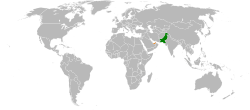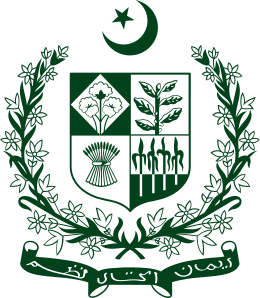Pakistan–United Arab Emirates relations
 |
|
Pakistan |
United Arab Emirates |
|---|---|
Pakistan–United Arab Emirates relations refer to bilateral relations between the Islamic Republic of Pakistan and the United Arab Emirates.
After the British left, Pakistan originally called for the UAE the successor of the Trucial States to include Bahrain and Qatar as states of the United Arab Emirates, this however never materialised and relations with Abu Dhabi were established in 1971, Islamabad was the first country to extend recognition and Pakistan and the UAE enjoy extremely close and fraternal relations, founded on deep-rooted cultural affinities, shared faith and traditions, as also geographic proximity and identity of interests mainly reciprocates Pakistan’s continued position on Jammu and Kashmir and urged the International community to play its role effectively in resolving the crises. These relations date back to the UAE's formation in 1971, and have since evolved into wide-ranging co-operation in various fields. UAE has been a major donor of economic assistance to Pakistan. UAE has been appreciative of Pakistan's contribution to the evolution of key institutions in the Emirates such as armed forces, police, health and education, and has reciprocated in the same friendly manner to the full satisfaction of Pakistan. Both countries are Islamic countries.
Frequent exchanges of high level visits and regular bilateral consultations between the two countries are reflective of the fact that Pakistan and UAE have laid strong foundations of mutually beneficial relations, friendship and peaceful cooperation over the years. The UAE has emerged as one of Pakistan's major economic and trading partners. A large number of Pakistani expatriates, numbering nearly 400,000 are gainfully employed in UAE. The Pakistani expatriates in UAE have contributed in a significant manner to promotion of bilateral understanding and to the economy of Pakistan through their home remittances. The relationship between the two has been dubbed as a special relationship.[1][2] The UAE also has a long cricket relationship with Pakistan, serving as a home ground for the Pakistan cricket team for the past few decades.[3]
Trade between the two countries was valued at $9 billion as of 2014.[4]
UAE Pakistan Assistance Program
On the 12th of January, 2011, the UAE Pakistan Assistance Program was launched in order to help and provide assistance to Pakistan and mitigate the impact of floods by redeveloping infrastructure, as per the directives of His Highness Sheikh Khalifa Bin Zayed Al Nahyan, the President of the United Arab Emirates. The UAE PAP has worked along a comprehensive redevelopment plan that takes into account the harsh geography and the rough weather conditions of the region while focusing on four main areas of social redevelopment: health, education, water and infrastructure. The Program has taken some vital steps to ease the pain and suffering that the people of Swat have become accustomed to as it provided for the construction and rehabilitation of two bridges, 52 schools and 7 hospitals, as well as the implementation of 64 water supply schemes.Uae Pakistan Assistance Program
Pakistani military relations with the UAE
The Pakistani military has had a historic role in helping to train and equip the UAE military, such as training fighter pilots of the UAE air force. Pakistan spymaster General Pasha became a security advisor to the UAE government upon his retirement from the Pakistani secret service.[5] Inside Pakistan the UAE has a lease for use of Shamsi Airfield located in Pakistan's Balochistan province.[6]
Pakistan’s did not join the Saudi-led operations in Yemen . This was made clear in comments by the Minister of State for Foreign Affairs, Dr Anwar Gargash, after a unanimous resolution was passed by a special session of Pakistan’s parliament to remain neutral in the Yemen arab conflict.[7] However, by June 2016 the UAE had itself withdrawn from the Yemen conflict due to pressure over civilian casualties.
See also
References
- ↑ "Discovering Islam". Retrieved 24 April 2016.
- ↑ "The UAE and Foreign Policy". Retrieved 24 April 2016.
- ↑ Osman Samiuddin. "Is Pakistan cricket's long-standing relationship with the UAE coming to an end?". Retrieved 24 April 2016.
- ↑ Bitar, Zaher (6 February 2015). "UAE-Pakistan Bilateral trade estimated at $9b in 2014". Gulf News. Retrieved 14 October 2016.
- ↑ https://www.thenewstribe.com/2013/02/25/uae-appoints-ex-isi-honcho-ahmed-shuja-pasha-as-advisor-report/
- ↑ http://tribune.com.pk/story/202213/the-curious-case-of-the-shamsi-airbase/
- ↑ Ayesha Almazroui. "Why is Pakistan not supporting its old friend at this critical time?". Retrieved 24 April 2016.
- A testimony to healthy relations
- UAE national day: Pakistan helped evolve UAE armed forces, says consul-general
- United Arab Emirates: a real friend of Pakistan
- Remembering Emirates’ first flights - 30 years on

